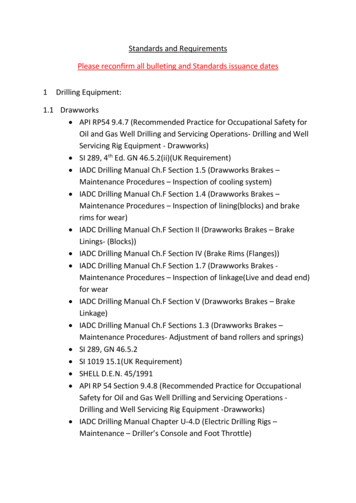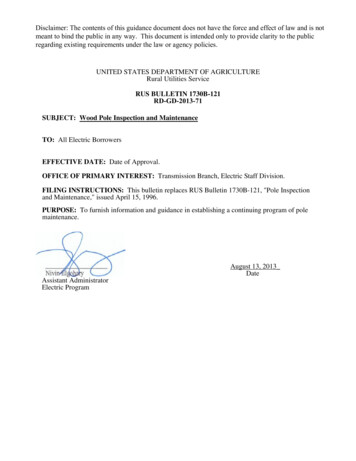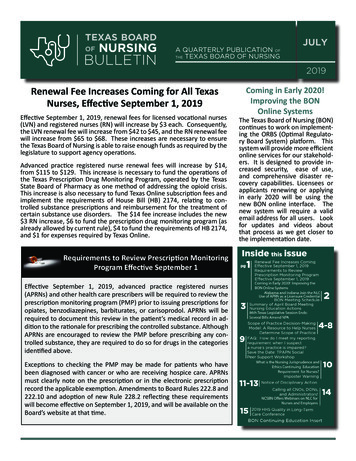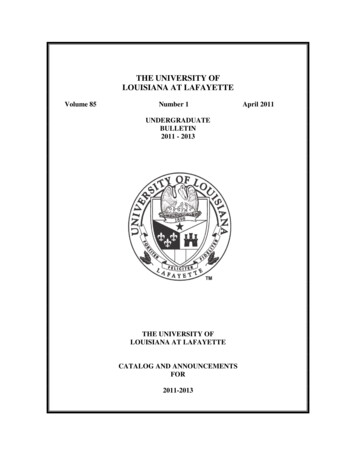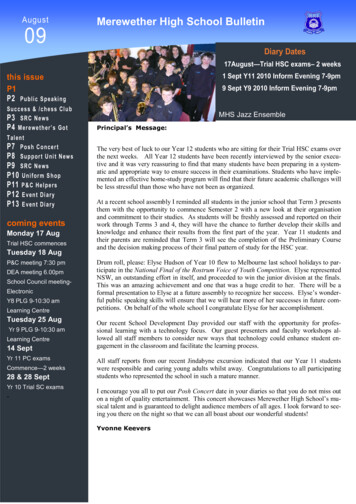
Transcription
BULLETINof theChicago Herpetological SocietyVolume 55, Number 6June 2020
BULLETIN OF THE CHICAGO HERPETOLOGICAL SOCIETYVolume 55, Number 6June 2020The Milksnake House: Eastern Milksnake, Lampropeltis triangulum, Oviposition inside the Top of a Chimney . . . . Stephen Barten113Solving the Mystery of Wood Frogs at Snake Road . . . . . . . . . . . . . . . . . . . . . . . . . . . . . . . . . . John G. Palis117American Crows Scavenge Green Frog Carcasses . . . . . . . . . . . . . . . . . . . . . . . . . . . . . . . Dreux J. Watermolen120Notes on Reproduction of Rio Grande Leopard Frogs, Lithobates berlandieri (Anura: Ranidae), from Texas . . . Stephen R. Goldberg121Forty-two New Township Records for Amphibians and Reptiles in Columbia County, Pennsylvania, USA. . . . . Sean M. Hartzell124A 41-year-old Red Milksnake (Lampropeltis triangulum syspila) . . . . . . . . . . . . . . . . . . . . . . Thomas (Tom) Zaremba126Nastycophis --- a Snake as Great as its Name (Part 3). . . . . . . . . . . . . . . . . . . . . . . . . . . . . . . . Roger A. Repp127Minutes of the CHS Board Meeting, June 4, 2020 . . . . . . . . . . . . . . . . . . . . . . . . . . . . . . . . . . . . . . . . . .132Advertisements . . . . . . . . . . . . . . . . . . . . . . . . . . . . . . . . . . . . . . . . . . . . . . . . . . . . . . . . . .132New CHS Members This Month . . . . . . . . . . . . . . . . . . . . . . . . . . . . . . . . . . . . . . . . . . . . . . . . . .132Cover: Snakemouth orchid, Pogonia ophioglossoides. Photograph by Stephen Barten.STAFFEditor: Michael A. Dloogatch --- madadder0@aol.comCopy editor: Joan Moore2020 CHS Board of DirectorsPresident: John GutierrezVice-president: Jessica WadleighTreasurer: John ArcherRecording Secretary: Gail OomensMedia Secretary: Annalisa KolbMembership Secretary: Mike DloogatchSergeant-at-arms: Mike ScottMembers-at-large: Rachel BladowJenny HansonTom MikoszImmediate Past President: Rich CrowleyMembership in the CHS includes a subscription to the monthlyBulletin. Annual dues are: Individual Membership, 25.00;Family Membership, 28.00; Sustaining Membership, 50.00;Contributing Membership, 100.00; Institutional Membership, 38.00. Remittance must be made in U.S. funds. Subscribersoutside the U.S. must add 12.00 for postage. Send membershipdues or address changes to: Chicago Herpetological Society,Membership Secretary, 2430 N. Cannon Drive, Chicago, IL 60614.Manuscripts published in the Bulletin of the Chicago Herpetological Society are not peer reviewed. Manuscripts and lettersconcerning editorial business should be e-mailed to the editor,mdloogatch@chicagoherp.org. Alternatively, they may be mailedto: Chicago Herpetological Society, Publications Secretary, 2430N. Cannon Drive, Chicago, IL 60614. Back issues are limited butare available from the Publications Secretary for 2.50 per issuepostpaid.Visit the CHS home page at http://www.chicagoherp.org .The Chicago Herpetological Society is a nonprofit organization incorporated under the laws of the state of Illinois. Itspurposes are education, conservation and the advancementof herpetology. Meetings are announced in this publication,and are normally held at 7:30 P.M., the last Wednesday ofeach month.The Bulletin of the Chicago Herpetological Society (ISSN0009-3564) is published monthly by the Chicago Herpetological Society, 2430 N. Cannon Drive, Chicago IL 60614.Periodicals postage paid at Chicago IL. Postmaster: Sendaddress changes to: Chicago Herpetological Society, Membership Secretary, 2430 N. Cannon Drive, Chicago IL 60614.Copyright 2020
Bulletin of the Chicago Herpetological Society 55(6):113-116, 2020The Milksnake House:Eastern Milksnake, Lampropeltis triangulum, Oviposition inside the Top of a ChimneyStephen Barten, DVMVernon Hills Animal Hospital1260 S Butterfield RdMundelein, IL, 60060sbartendvm@gmail.comI have lived in the same Chicago suburb, on the same block,for 40 years. My village has a man-made lake, oak-hickorywoodlands, remnant patches of native plants, and a large fen.The fen is a preserve, the ownership of which is divided betweenLake County (Illinois) Forest Preserve District, Illinois NaturePreserves, and Citizens for Conservation. The latter is a large,active, local conservation group that is funded by donations andstaffed by volunteers. A fen is a type of wetland fed by mineralrich, alkaline groundwater, unlike acidic bogs, and which supports specialized native plants. A survey done in the early 2000sfound over 100 native plant species in our local fen, includingstate-threatened false asphodel, grass pink, beaked spike rush,and bog bedstraw. Additional native species found here includesnakemouth orchid (Figure 1) (and other orchids), turtlehead,Kalm’s lobelia, closed gentian, native yellow and pink loosestrife, and many varieties of aster. Unfortunately, much of thefen is overrun with cattails, with patches of Phragmites andbuckthorn, and is in need of restoration.All of this beautiful habitat supports a significant populationof native herpetofauna. Eastern foxsnakes, Pantherophis vulpinus,are fairly common near the fen and neighbors often report seeingthem. Chicago gartersnakes, Thamnophis sirtalis semifasciatus,and Dekay’s brownsnakes, Storeria dekayi, also are common inthe area. The lake is full of midland painted turtles, Chrysemyspicta marginata, and common snapping turtles, Chelydra serpentina, with occasional spiny softshells, Apalone spinifera. Aneighbor once called me to report she had found an escaped“box turtle” in her yard, but it proved to be a native Blanding’sturtle, Emydoidea blandingii, that had come up out of the fen tolay her eggs in the woman’s yard. I have seen six species of anuranhere and also low numbers of tiger salamanders, AmbystomaFigure 1. Snakemouth orchid, Pogonia ophioglossoides, a rare nativeplant found in our local fen, the presence of which confirms the qualityof this habitat. Also known as adder’s mouth, dragon’s mouth, rosecrested orchid, and rose pogonia, the species name translates as “snaketongue.” (Unless otherwise credited, images are by the author.)tigrinum, and blue-spotted salamanders, Ambystoma laterale.However, in all my decades of living here, until recently I hadnever seen an eastern milksnake, Lampropeltis triangulum, inthis village. The closest population I knew of was about fivemiles away.My wife is on the board of directors for Citizens for Conservation. A couple of years ago CFC received an email from aresident somewhere in the general area; it included an image ofa snake that person had seen in her yard and a request for identification (Figure 2). The email was forwarded to my wife so thatit could be passed on to me for an answer due to my well knowninterest in herpetology. The snake was a beautiful easternmilksnake. I replied with that information and asked where theperson lived. The answer surprised me; the family lived only ablock from my house and had recently moved in.I knew the former owner of that house. He had reportedseeing snakes around and inside his house with some frequency,but every one he ever showed me was either a foxsnake or agartersnake.The house is on a partially wooded lot and is unique in beingsurrounded on three sides by that beautiful fen. It is a one-storyranch house with a sunroom and wooden deck, both of whichface southeast and get lots of sun. There is a small basement,perhaps 400 square feet, to hold the furnace and hot water heaterand provide storage. A four-foot-deep crawlspace lies under therest of the house. There is a working fireplace in the living roomwith a brick chimney that extends down into the basement onone side and crawlspace on the other to provide venting for thefurnace and hot water heater.Luckily the new homeowners, while knowing little aboutsnakes, respect all life and accept that snakes have an importantrole in the ecosystem. They were eager to learn about the snakesFigure 2. The original image sent by a local homeowner requestingidentification of this snake found in her yard. It was an easternmilksnake, Lampropeltis triangulum. Image by the homeowner.113
Figure 3. (Left) This neonate eastern milksnake, Lampropeltis triangulum, was found crawling in the homeowner’s yard on 21 August 2018. (Right) Asecond neonate eastern milksnake, this one with a large food bolus, was also seen on the crawl and photographed by the homeowner on 26 September 2018.in their yard, how to identify them, understand their habits, andto take steps to ensure their safety. That summer they sent meseveral images of the foxsnakes and gartersnakes that theyencountered, and in the fall they twice found and showed metiny, recently hatched milksnakes in their yard (Figure 3). Thatpleased me, because it proved successful reproduction in thisvery focal milksnake colony.Last summer, the homeowners undertook some home improvement projects. They replaced the wooden deck on thesouth side of their house. Underneath was a jumble of fist-sizedrocks and dozens of shed snake skins, indicating frequent use bythe local snakes. Their contractor was terrified of snakes. Onemorning the homeowners found a small milksnake in the construction area and put it in a container to keep it away from thecontractor. They invited me to come see and photograph theFigure 4. A clutch of empty, hatched, snake eggshells as found insidethe the chimney between the outer bricks and flue liner just below thechimney cap. The eggs were found on 17 November 2018. Image by themason for the Lindemann Chimney Company.114snake. While standing there I saw a gartersnake’s tail protrudingfrom under the siding of their house where it met the foundation.I also moved a small board leaning up against the foundationand uncovered a second, larger milksnake and a second gartersnake. We moved the snakes around the corner of the house andreleased them under a wooden walkway.Part of the home improvement project included repair of thebrick chimney. The chimney cap at the top was cracked andpotentially leaking when it rained. When the mason removed thecap and a few bricks, he was surprised to find a clutch of snakeeggshells inside near the very top of the chimney. The eggshellswere between the outer bricks and the flue liner (Figure 4). Theowners saved the eggshells and later presented them to me foridentification and comment. There were 12 dried, irregular,leathery, off-white eggshells stuck together in a cluster, obviously from a snake. Eleven of them had multiple slits and wereempty, indicating successful hatching. A single egg was darkerthan the rest and lacked slits. It was either infertile or had suffered fetal death, but by the time the eggs were was found it wasdry and shriveled. The eggs measured 23–31 mm 12–18 mm(mean 28.3 mm 15.3 mm) (Figure 5). The eggs were found on17 November 2018, but I didn’t see them until the followingJuly. Based on the dried consistency and white, rather thanbrown, color of the eggs I estimated that they were from theprior summer.Figure 5. Close-up of the snake eggshells found inside the chimney.Note that there are 12 eggshells adhered together in a clump. All but onehave multiple slits indicating successful hatching.
Figure 6. Eastern foxsnake, Pantherophis vulpinus, eggshells, left, andeastern milksnake, Lampropeltis triangulum, eggshells, right. Scale incm. Note that the foxsnake eggs are considerably larger than those fromthe milksnake. Measurements are reported in the text.The only two egg-laying snake species in this area are milksnakes and foxsnakes. I happened to have bred a captive foxsnakeseveral years ago and saved the hatched eggshells for educationpurposes. Those eggs were significantly larger, measuring 40–57mm 23–33 mm (mean 45.8 mm 26.7 mm, n 9) (Figure 6).The obvious conclusion was that the chimney eggs were from amilksnake.One of the homeowners’ concerns during home improvementswas the presence of mice in their crawlspace. The contractor thussealed cracks between the house and its foundation. Likewise,an attempt was made to seal the crawlspace itself. After theweather turned cold last fall, they began finding snakes insidetheir house, both in the crawlspace and in the sunroom. Fearfulthat the snakes would not be able to find a way back outside inthe spring due to the repairs, they brought them to me to holdover the winter for release in the spring. They found snakesirregularly throughout the winter, between one and four at a time.Interestingly, all of the house snakes were subadults. Noadults were found, although the year before a large, unidentifiedsnake was seen in the crawlspace. Some of the snakes were tinyneonates, and some showed enough growth to indicate that theywere in their second or third year. The homeowners found ninegartersnakes over the winter, all relatively the same size andlikely born last summer. There were four foxsnakes. Based ontheir size, three of them were judged to be last year’s hatchingsand one a year older. They found seven milksnakes. Four ofthem were tiny neonates, making it likely that they hatchedinside the house and had not yet found their way outside. Theother three milksnakes showed considerable growth but werenot adult size (Figure 7).All of these snakes found in the house were kept in glassaquariums with screen tops, small clay hides, paper substrate,water bowls, and plastic containers with moist sphagnum mossto provide a humidity source. The aquariums were kept in a coolbasement until late March, when they were moved to a warmerbasement. They were released in the owner’s yard under coverin early May.DiscussionIn the wild eastern milksnakes have been recorded layingeggs in rotting logs and stumps, piles of decaying vegetation,Figure 7. Some of the snakes found inside the crawlspace and sunroomof the house during the winter of 2019–2020. The group on the leftcontains larger but still subadult snakes: three eastern milksnakes,Lampropeltis triangulum, and one eastern foxsnake, Pantherophisvulpinus. The group on the right contains smaller, young-of-the-yearsnakes: three eastern milksnakes, one eastern foxsnake, and fourChicago gartersnakes, Thamnophis sirtalis semifasciatus.sawdust piles, under rocks, behind the bark of trees, and inmammal burrows. Multiple females may use the same site(Henderson et al., 1980). One clutch of eight eggs was foundunder a decaying timber (Minton, 1971).Eastern milksnakes frequently enter houses, basements, andfoundations in the fall while searching for brumation sites (Harding, 2000). They have been reported to take up residence in abuilding harboring a population of mice (Barbour, 1971). Infact, another name occasionally mentioned in the literature forthe milksnake is “house snake” (Wright and Wright, 1957;Harding, 2000). It is not unreasonable that they might also enterhuman dwellings for the purpose of egg-laying. What is unusualhere is that a milksnake found a way to the top of the chimney todeposit her eggs.Arboreal snake species have been known to deposit eggs wellabove the ground in tree cavities with some regularity (e.g., seePlummer, 1990). Although eastern milksnakes are said to beexcellent climbers and have been reported to “rest along therafters or other elevated timbers in a building” (Barbour, 1971),they are not generally considered arboreal in nature. In a studyof eastern milksnakes in McHenry County, Illinois, 59 specimenswere collected. All were found under cover on the ground (carhood, discarded rug, plywood, flat rocks) except for one crawlingon the ground and two road-killed specimens (Dyrkacz, 1977).There are two possible ways this milksnake could have madeits way inside the top of the chimney. One is from the outside.There are three or four trees close to this one-story house thatare tall enough for some of their branches to slightly overhangthe roof. It is possible that the gravid milksnake climbed one ofthose trees, dropped onto the roof, and crawled from the edge ofthe roof across the bare shingles to the chimney near the peak ofthe roof. It then would have had to climb the brick chimney andfind the crack in the chimney cap to enter (Figure 8). One of themost common adjectives used to describe the behavior of eastern milksnakes is “secretive” (Ernst and Barbour, 1989, Ernstand Ernst, 2003, Harding, 2000). Milksnakes often remainunderground or under logs, rocks, and other cover, but are rarely115
milksnakes in the crawlspace suggests that another clutch ofeggs hatched inside the house last fall and at least some of theneonates never made it outside. If these latest neonates alsohatched in the chimney, there is a connection between the chimney and the crawlspace on the inside of the house. It is likelythat the milksnake entered the chimney to lay her eggs from thecrawlspace of the house rather than from the outside.Figure 8. The chimney in which the snake eggshells were found, asseen from the driveway in front of the house after repairs were complete.For a gravid milksnake to have entered this chimney from the outside,as opposed to from inside the crawlspace, it would have had to climb anadjacent tree, drop onto the roof, crawl across the open span of shinglesto the chimney at the peak of the roof, climb the chimney, and find acrack to enter near the top. This seems unlikely.described as arboreal. Entry from the outside seems unlikely.The other way the snake might have entered the chimney isfrom inside the house. The chimney extends into the basementof this house, and the furnace and hot water heater vent throughthe chimney. The back of the chimney is in the crawlspace.Because the house had cracks and crevices through which bothmice and snakes entered with frequency, it seems likely that asnake could have entered the crawlspace and found a crack orgap in the chimney on the inside. Once the snake ascended tothe top between the bricks and the flue liner, assuming adequatehumidity, the sun-warmed bricks could have offered an idealoviposition site. The recent presence of at least four neonateEastern milksnake egg size has been reported as 21–35 mm 11–15 mm (Ernst and Barbour, 1989) and 22–62 mm 6–22mm (mean 38.2 14.7, n 91) (Ernst and Ernst, 2003). Themean size of 29 milksnake eggs from McHenry County, Illinois,was 32 16.4 mm (Dyrkacz, 1977). Egg size is proportionalto female length. Clutch size varies from 1 to 24, average 7.6(n 145) (Ernst and Ernst, 2003). This is consistent with mymeasurements of the 12 chimney eggshells at 23–31 mm 12–18 mm (mean 28.3 mm 15.3 mm).Foxsnake egg size has been reported as 29–58.5 14.5–30mm, (Ernst and Barbour, 1989) and 29–61 mm 14–30 mm,(mean 46.2 24.1 mm, n 29 and 24 respectively) (Ernst andErnst, 2003). Clutch size varies from 7 to 29. (Ernst and Ernst,2003). This also is consistent with my measurements of foxsnake eggshells at 40–57 mm 23–33 mm (mean 45.8 mm 26.7 mm) and supports my conclusion that the chimney eggswere from an eastern milksnake.Eastern milksnake eggs have not previously been reported inelevated locations.AcknowledgmentI thank Mike Dloogatch for assistance in locating referencesand preparation of the manuscript.Literature CitedBarbour, R. W. 1971. Amphibians and reptiles of Kentucky. Lexington: University Press of Kentucky, Kentucky Nature Studies Number 2.Dyrkacz, S. 1977. The natural history of the eastern milk snake (Reptilia, Serpentes, Colubridae) in a disturbed environment. Journal ofHerpetology 11(2):155-159.Ernst, C. H., and R. W. Barbour. 1989. Snakes of eastern North America. Fairfax, Virginia: George Mason University Press.Ernst, C. H., and E. M. Ernst. 2003. Snakes of the United States and Canada. Washington, D.C.: Smithsonian Books.Harding, J. H. 2000. Amphibians and reptiles of the Great Lakes Region. Ann Arbor: The University of Michigan Press.Henderson, R. W., M. H. Binder, R. A. Sajdak and J. A. Buday. 1980. Aggregating behavior and exploitation of subterranean habitat bygravid eastern milksnakes (Lampropeltis t. triangulum). Milwaukee Public Museum, Contributions in Biology and Geology 32:1-9.Minton, S. A., Jr. 2001. Amphibians and reptiles of Indiana, revised second edition. Indianapolis: The Indiana Academy of Science.Plummer, M. V. 1990. Nesting movements, nesting behavior, and nest sites of green snakes (Opheodrys aestivus) revealed byradiotelemetry. Herpetologica 46(2):190-195.Wright A. H., and A. A. Wright. 1957. Handbook of snakes of the United States and Canada. Volume 1. Ithaca, New York: ComstockPublishing Associates, Cornell University Press.116
Bulletin of the Chicago Herpetological Society 55(6):117-120, 2020Solving the Mystery of Wood Frogs at Snake RoadJohn G. PalisPalis Environmental ConsultingP.O. Box 387Jonesboro, IL 62952jpalis@yahoo.comThis, our smallest Rana, awakens, spawns, and disappears into the woods, in such quick succession that it generally escapesnotice. --- Wright, 1914, referring to the Wood Frog.AbstractDue to their cryptic coloration and habits, Wood Frogs (Rana sylvatica) often go unnoticedexcept during their brief breeding season. Wood Frogs were not detected during twoherpetofaunal surveys of LaRue-Pine Hills (Snake Road), the first conducted in the 1950sand the second in the late 1980s through early 1990s. Since these surveys, several anecdotalreports of Wood Frogs at Snake Road have come to light. The provenance of these WoodFrogs has been a mystery. With the recent discovery of seven Wood Frog breeding sites inthe lowlands near Snake Road, the mystery has been solved.IntroductionRanging from the Piedmont of northwestern Georgia, northto northern Quebec and Labrador, and northwest to the BeringSea of western Alaska, Wood Frogs (Rana sylvatica) have themost extensive range of any North American frog (Dodd, 2013).In Illinois, Wood Frogs inhabit the northwestern and northeastern corners of the state, the eastern border with Indiana, andseveral extreme southern counties (Phillips et al., 1999). Insouthernmost Illinois, the species is apparently restricted to theeastern and western Shawnee Hills and the Illinois Ozarks(Redmer, 2002).Wood Frogs are closely associated with closed-canopyforests, including deciduous, coniferous, or mixed deciduousconiferous (Redmer, 2002; Dodd, 2013). Breeding habitatconsists of ditches, road ruts, and woodland pools and pondsthat typically dry annually, thus excluding predatory fishes(Dodd, 2013).Recently, Palis et al. (2019) summarized anecdotal observations of Wood Frogs at Snake Road, LaRue-Pine Hills, ShawneeNational Forest, in northwestern Union County, Illinois (seePalis [2016] for a map and description of the area). Wood Frogsare infrequently detected at Snake Road, with reports of a singleobservation occurring sometime between 1968 and 1971 (Ballard,1994), and two recent observations of one frog each in 2017and 2018 (Palis et al., 2019). The occurrence of Wood Frogsat Snake Road is something of a mystery. What is the origin ofthese infrequently-detected individuals? Do they representdispersers from a distant breeding population in the Pine Hillsto the east or is there a breeding population at Snake Road?clear-water pool (Figure 1). The frogs were now concealedbeneath submerged leaf litter at the bottom of the pool. Thewater temperature was 16.5EC. I found a cluster of 15 recentlyoviposited Wood Frog egg masses in water 11.5 cm deep. Theapproximately 27-foot-wide pool was confluent with an extensive, shallowly-flooded, lowland forest, dominated by red maple(Acer rubrum). The muddy, undulating forest floor alternatedbetween hummocks, lentic pools, and a shallow spring-run.When the Wood Frogs stopped calling at the pool, I could hearothers vocalizing elsewhere.During the afternoon of 4 March 2020, I returned to the redmaple forest. Upon re-examination of the Wood Frog pool at1455 CST, I discovered three newly-deposited egg masses in theegg mass cluster, bringing the total to 18 Wood Frog eggmasses. I then left the pool and explored the surrounding areawest of the road. At 1548 CST, I heard quiet, single-note“quacks” of male Wood Frogs emanating from an old, lentic,human-made ditch. The ditch, which passes through foresthaving a canopy of black oak (Quercus velutina), bur oak(Quercus macrocarpa), red oak (Quercus rubra), white oak(Quercus alba), sweetgum (Liquidambar styraciflua), white ash(Fraxinus americana), and shagbark hickory (Carya ovata),held several separate, clear-water pools of varying lengths. TheWood Frog ObservationsAt 1330 CST, 3 March 2020, while walking northward alongthe Pine Hills bluff east of Snake Road, I heard the distinctive,duck-like “quacking” vocalizations of male Wood Frogs west ofthe road. The sky was clear and the air temperature was 18EC. Ifollowed the calls westward and --- through binoculars --- observeda minimum of a dozen Wood Frogs at the surface of a woodlandpool. By 1337 CST, I reached the shallow (# 11.5 cm), lentic,Figure 1. Wood Frog breeding pool in red maple forest, 3 March 2020.117
Figure 2. Wood Frog breeding ditch in oak-hickory-sweetgum-ashforest, 4 March 2020.Figure 3. Wood Frog breeding pool in oak-hickory-sugarberrysweetgum-elm forest, 5 March 2020.shallow (#15 cm), 10.5 m long 1.5 m wide (maximum width),leaf-choked pool where the frogs had been calling contained onefreshly-deposited Wood Frog egg mass in water 15 cm deep.The water temperature was 12EC. I followed the ditch southward and encountered a cluster of seven recently-laid WoodFrog egg masses in a leaf-filled pool measuring 27.5 m long, amaximum of 1.8 m wide, and up to 18 cm deep (Figure 2). Theeggs were clustered in the deepest portion of the ditch. Watertemperature was 12EC. Upon returning to the swampy red-mapleforest, I found a single, recently-deposited Wood Frog egg massat 1635 CST. The mass was deposited in water 4 cm deep in aclear-water pool # 7.5 cm deep.oak, white oak, shagbark hickory, sugarberry (Celtis laevigata),sweetgum, and slippery elm (Ulmus rubra) (Figure 3). Airtemperature was 19.5EC. I discovered 31 Wood Frog eggmasses in the northeast quadrant of the pond. Three egg masseswere laid singly and four clusters consisted of 4 to 10 eggmasses each. I detected an additional Wood Frog egg mass inthe southwest quadrant of the pond. Egg masses were laid inwater # 18.5 cm deep.I returned to the area on 5 March 2020 to continue searchingfor recently-deposited Wood Frog eggs. At 1130 CST, I initiatedmy search in the forest southeast of the Big Muddy River leveeand northeast of the railroad tracks. Air temperature was 16EC.I heard multiple choruses of Southern Leopard Frogs (Ranasphenocephala), as well as calls of a single Plains Leopard Frog(Rana blairi) and several Spring Peepers (Pseudacris crucifer),but I did not detect Wood Frogs. I then drove to the south endof Snake Road, parked near the gate, and walked approximately0.5 km north on the road and then west into the forest. At 1500CST, I heard subdued Wood Frog calls emanating from a rectangular (90 m 14 m) pool, presumably of human origin, within aforest composed of pin oak (Quercus palustris), red oak, burFigure 4. Two Wood Frog egg masses, 8 March 2020.118I conducted my final Wood Frog egg mass survey on 8March 2020. At 1250 CDST, I detected a cluster of six WoodFrog egg masses attached to a branch in water 25-cm deep in a1.5 11 m pool. This pool is within the circle of the WintersPond parking lot near the north end of Snake Road and is bordered by a stand of black willow (Salix nigra). I found an additional Wood Frog breeding site west of Snake Road at 1400CDST, approximately 1.5 km south of the parking lot, in forestcomposed of pin oak, cherrybark oak (Quercus pagoda), redoak, sugarberry, slippery elm, red maple, white ash, water locust(Gleditsia aquatica), sweetgum, persimmon (Diospyrosvirginiana), and bald cypress (Taxodium distichum). Two eggmasses were deposited side by side on the bottom in water 6 cmdeep within a shallow (8 cm deep), 3.5 m 8 m pool (Figure 4).Water temperature was 16.5EC. I also observed an adult maleWood Frog at this pool (Figure 5).Figure 5. Adult male Wood Frog found at breeding site, 8 March 2020.
In summary, I found 67 Wood Frog egg masses in sevenshallow pools west of Snake Road, between Winters Pond andthe south gate. Sixty-one (91%) of the egg masses were laidcommunally in clusters of 2–18 masses.DiscussionDespite more than 650 hours on-site since 1996, these aremy first observations of Wood Frogs at Snake Road. WoodFrogs also went undetected during two herpetofaunal surveys ofthe area (Rossman, 1960; Ballard, 1994). Why do Wood Frogstend to go unnoticed at Snake Road? I suspect timing ofherpetofaunal surveys, as well as the natural history of WoodFrogs, may provide the answer.The vast majority of my visits to Snake Road occur duringthe road closure periods, March 15 through May 15 in spring,and September 1 through October 30 in autumn. These dates areoutside the typical late February through early March WoodFrog breeding season in southernmost Illinois (Redmer, 2002).As a result, most of my visits to Snake Road do not overlap theWood Frog breeding season. Furthermore, I visit Snake Roadprincipally during daylight hours and Wood Frogs vocalize mostfrequently at night in southernmost Illinois (Redmer, 2002).Surveys conducted by Rossman (1960) and Ballard (1994)included visits in February and March, and both individualssearched the lowland forest between the road and the swamp,the area where I detected Wood Frogs. Rossman (1960:210)specifically examined “wooded lowland pools” for the presenceof pond-breeding salamanders. Wood Frogs are explosive breeders, often completing breeding in less than a week (Redmer,2002; Dodd, 2013). As such, timing is critically important in thedetection of breeding Wood Frogs. It is possible that Rossman(1960) and Ballard (1994) missed Wood Frogs simply becausethey were not in the right place at the right time. Furthermore,Wood Frog vocalizations have limited carrying power (Wrightand Wright, 1949; Gerhardt, 1975) so they may go undetect
A clutch of empty, hatched, snake eggshells as found inside the the chimney between the outer bricks and flue liner just below the chimney cap. The eggs were found on 17 November 2018. Image by the mason for the Lindemann Chimney Company. Figure 5. Close-up of the s

